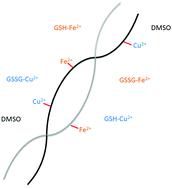当前位置:
X-MOL 学术
›
Metallomics
›
论文详情
Our official English website, www.x-mol.net, welcomes your feedback! (Note: you will need to create a separate account there.)
The role of metal ion binding in the antioxidant mechanisms of reduced and oxidized glutathione in metal-mediated oxidative DNA damage.
Metallomics ( IF 3.4 ) Pub Date : 2019-11-14 , DOI: 10.1039/c9mt00231f Elias O U Eteshola 1 , Devin A Haupt , Stephen I Koos , Lee A Siemer , Daniel L Morris
Metallomics ( IF 3.4 ) Pub Date : 2019-11-14 , DOI: 10.1039/c9mt00231f Elias O U Eteshola 1 , Devin A Haupt , Stephen I Koos , Lee A Siemer , Daniel L Morris
Affiliation

|
The antioxidant activity of glutathione in its reduced (GSH) and oxidized (GSSG) forms against metal-mediated oxidative DNA damage was studied by monitoring production of 8-hydroxy-2′-deoxyguanosine (8-OH-dG) from calf-thymus DNA. GSH and GSSG were combined with Fe(II) and Cu(II) before and after addition of DNA to investigate the role of metal coordination in the antioxidant mechanism. The antioxidant behavior of GSH and GSSG was also compared to the known radical scavenger DMSO. GSH and GSSG lower oxidative DNA damage for Fe(II) and Cu(II) reactions. GSH only exhibited appreciable antioxidant behavior when combined with Fe(II) prior to adding DNA, and GSH and GSSG were slightly more effective against Cu(II)-mediated damage when combined with Cu(II) prior to adding DNA. Raman spectra of GSH in the presence of Cu(II) indicate that Cu(II) oxidizes GSH and raises the possibility that the antioxidant activity of GSH against Cu(II) reactions may be attributed to its ability to form GSSG. No evidence of GSH oxidation in the presence of Fe(II) was observed. The fluorescent probe dichlorofluorescein diacetate (DCF-DA) shows that the presence of GSH (for Cu(II) reactions) and GSSG (for Fe(II) and Cu(II) reactions) lowers levels of reactive oxygen species (ROS) in bulk solution. Overall, the results suggest that the mechanism of antioxidant activity for GSH and GSSG against Fe(II) and Cu(II)-mediated oxidative damage involves metal coordination, and isothermal titration calorimetry (ITC) studies of the Cu(II)–GSSG system show an enthalpically favored complexation reaction with an apparent 1 : 1 stoichiometry.
中文翻译:

金属离子结合在金属介导的氧化性DNA损伤中还原和氧化的谷胱甘肽的抗氧化机制中的作用。
通过监测小牛胸腺DNA产生的8-羟基-2'-脱氧鸟苷(8-OH-dG),研究了谷胱甘肽的还原态(GSH)和氧化态(GSSG)对金属介导的氧化性DNA损伤的抗氧化活性。 。在添加DNA之前和之后,将GSH和GSSG与Fe(II)和Cu(II)结合,以研究金属配位在抗氧化机理中的作用。还将GSH和GSSG的抗氧化性能与已知的自由基清除剂DMSO进行了比较。GSH和GSSG降低了Fe(II)和Cu(II)反应的氧化DNA损伤。GSH仅在添加DNA之前与Fe(II)结合时才表现出明显的抗氧化性能,而GSH和GSSG对Cu(II)介导的损伤,在添加DNA之前与Cu(II)结合时。在存在Cu(II)的情况下,GSH的拉曼光谱表明,Cu(II)氧化了GSH,并增加了GSH对Cu(II)反应的抗氧化活性可能归因于其形成GSSG的能力。没有观察到在Fe(II)存在下GSH氧化的证据。荧光探针二乙酸二氟荧光素(DCF-DA)表明存在GSH(对于Cu(II)反应)和GSSG(对于Fe(II)和Cu(II))反应)降低了本体溶液中的活性氧(ROS)含量。总体而言,结果表明,GSH和GSSG对Fe(II)和Cu(II)介导的氧化损伤的抗氧化剂活性机制涉及金属配位,以及Cu(II)-GSSG系统的等温滴定热(ITC)研究图1显示了化学计量比为1:1的焓有利的络合反应。
更新日期:2019-11-14
中文翻译:

金属离子结合在金属介导的氧化性DNA损伤中还原和氧化的谷胱甘肽的抗氧化机制中的作用。
通过监测小牛胸腺DNA产生的8-羟基-2'-脱氧鸟苷(8-OH-dG),研究了谷胱甘肽的还原态(GSH)和氧化态(GSSG)对金属介导的氧化性DNA损伤的抗氧化活性。 。在添加DNA之前和之后,将GSH和GSSG与Fe(II)和Cu(II)结合,以研究金属配位在抗氧化机理中的作用。还将GSH和GSSG的抗氧化性能与已知的自由基清除剂DMSO进行了比较。GSH和GSSG降低了Fe(II)和Cu(II)反应的氧化DNA损伤。GSH仅在添加DNA之前与Fe(II)结合时才表现出明显的抗氧化性能,而GSH和GSSG对Cu(II)介导的损伤,在添加DNA之前与Cu(II)结合时。在存在Cu(II)的情况下,GSH的拉曼光谱表明,Cu(II)氧化了GSH,并增加了GSH对Cu(II)反应的抗氧化活性可能归因于其形成GSSG的能力。没有观察到在Fe(II)存在下GSH氧化的证据。荧光探针二乙酸二氟荧光素(DCF-DA)表明存在GSH(对于Cu(II)反应)和GSSG(对于Fe(II)和Cu(II))反应)降低了本体溶液中的活性氧(ROS)含量。总体而言,结果表明,GSH和GSSG对Fe(II)和Cu(II)介导的氧化损伤的抗氧化剂活性机制涉及金属配位,以及Cu(II)-GSSG系统的等温滴定热(ITC)研究图1显示了化学计量比为1:1的焓有利的络合反应。

























 京公网安备 11010802027423号
京公网安备 11010802027423号